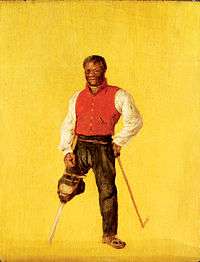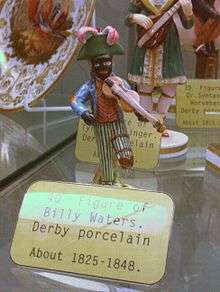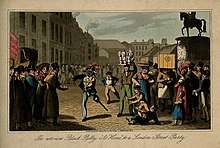Billy Waters (busker)
Billy Waters (c. 1778–1823) was a black man who busked in London in the nineteenth century by singing, playing the violin and entertaining theatre goers with his "peculiar antics". He became famous when he appeared as a character in William Thomas Moncrieff's Tom and Jerry, or Life in London in 1821.[1]
Billy Waters | |
|---|---|
 maybe by Sir David Wilkie | |
| Born | c. 1778 |
| Died | 1823 St Giles Workhouse, London |
| Occupation | Beggar, performer |
Biography
Billy Waters came to notice as a beggar on the streets of London where he played the violin to entertain theatre-goers in exchange for halfpennies. It is said that he was once a slave in America who traded his servitude to be a British sailor.[2] His striking image was established by his African ancestry, a naval uniform, his peg leg, his violin and the addition of a feathered hat. Waters had lost his leg as a sailor in the navy when he fell from the rigging,[3] although other sources imply he lost it while fighting in the American War of Independence. He had a wife and two children to support,[4] and in the 1780s he would busk outside the Adelphi Theatre.[5] Waters and his "peculiar antics" became so famous that he was asked to appear on stage as himself.[5]
Waters was one of the London characters who appeared in William Thomas Moncrieff's Tom and Jerry, or Life in London, an unauthorised stage adaptation of Pierce Egan's Life in London, or Days and Nights of Jerry Hawthorne and his elegant friend Corinthian Tom, in 1821.[1] Waters was one of the only 10,000 people of African heritage who were making a living at this time in England.[6] He was very poor and it is said that he was twice saved from the punishment of the treadmill due to his peg leg.[1]
At the end of his life, Waters was popularly elected as the "King of the Beggars" in the parish of St Giles because of his fame and the regard of his peers. His small naval pension had left him so poor that he had to sell his violin and it was said that he would have also sold his wooden leg but it was worthless with wear. Waters became ill and had to enter the St Giles' workhouse where he died in 1823 after ten days.[1][4]
Billy Waters' will was in verse and one section read:[5]
Thus poor Black Billy's made his Will,
His Property was small good lack,
For till the day death did him kill
His house he carried on his back.
The Adelphi now may say alas!
And to his memory raise a stone:
Their gold will be exchanged for brass,
Since poor Black Billy's dead and gone.
Legacy


After his death, his figure was recreated in porcelain – notably by the Staffordshire potteries,[1] but also by Derby porcelain.[7] The figure shown is also in the Victoria and Albert Museum and this re-issue has been dated to 1862. These figures were made in Derby nearly forty years after Waters' death at the Derby factory of Stevenson & Hancock. The modelling by Edward Keys was an attempt to win away trade from cheaper Staffordshire ceramic figures.[8] There is a sketch of Waters by Thomas Lord Busby which comes from his book Costume of the Lower Orders of London.[9][1] A more realistic painting is attributed to Sir David Wilkie.

The pottery figure however is similar to an engraving done by George Cruikshank in 1819 where Waters is shown providing entertainment for a fictional "celebrated dinner" of those involved in Anti-Slavery. Several notable abolitionists are lampooned in this engraving.[2] One of the similarities are that the same leg is missing, which contrasts with the different missing leg in the Sir David Wilkie portrait.
References
- "Billy Waters - Soldier, Actor and Musician". Black Presence. National Archives. Retrieved 9 August 2011.
- "The New Union: Club, Being a Representation of what took place at a celebrated Dinner, given by a celebrated - society (ZBA2498)". Collections on-line. National Maritime Museum. Retrieved 17 August 2011.
- Fryer, Peter (1984). Staying Power: The History of Black People in Britain p231. ISBN 9780861047499.
- Billy Waters, Abolition of Slavery, National Portrait Gallery, London, accessed August 2011.
- Billy Waters, Adelphi Theatre, the Strand, Museum of London Docklands, accessed August 2011.
- Billy Waters, V&A, accessed August 2011.
- Label on Billy Waters Figure, Derby Museums, accessed August 2011.
- Figure – Billy Waters, Victoria and Albert Museum, accessed August 2011.
- "Billy Waters" in Thomas Lord Busby, Costumes of the Lower Orders of London (Baldwin & Co. 1820), in the New York Public Library Digital Collections.